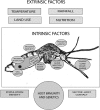Invasiveness of Aedes aegypti and Aedes albopictus and Vectorial Capacity for Chikungunya Virus
- PMID: 27920173
- PMCID: PMC5137242
- DOI: 10.1093/infdis/jiw285
Invasiveness of Aedes aegypti and Aedes albopictus and Vectorial Capacity for Chikungunya Virus
Abstract
In this review, we highlight biological characteristics of Aedes aegypti and Aedes albopictus, 2 invasive mosquito species and primary vectors of chikungunya virus (CHIKV), that set the tone of these species' invasiveness, vector competence, and vectorial capacity (VC). The invasiveness of both species, as well as their public health threats as vectors, is enhanced by preference for human blood. Vector competence, characterized by the efficiency of an ingested arbovirus to replicate and become infectious in the mosquito, depends largely on vector and virus genetics, and most A. aegypti and A. albopictus populations thus far tested confer vector competence for CHIKV. VC, an entomological analog of the pathogen's basic reproductive rate (R0), is epidemiologically more important than vector competence but less frequently measured, owing to challenges in obtaining valid estimates of parameters such as vector survivorship and host feeding rates. Understanding the complexities of these factors will be pivotal in curbing CHIKV transmission.
Keywords: Aedes aegypti; Aedes albopictus; chikungunya; competitive displacement; invasiveness; satyrization; vector competence; vectorial capacity.
© The Author 2016. Published by Oxford University Press for the Infectious Diseases Society of America. All rights reserved. For permissions, e-mail journals.permissions@oup.com.
Figures
References
-
- Juliano SA, Lounibos LP. Invasions by mosquitoes: the roles of behaviour across the life cycle. In: Weis JS, Sol D, eds. Behaviour in biological invasions. Cambridge, United Kingdom: Cambridge University Press, 2016.
-
- Lounibos LP. Invasions by insect vectors of human disease. Annu Rev Entomol 2002; 47:233–66. - PubMed
Publication types
MeSH terms
Grants and funding
LinkOut - more resources
Full Text Sources
Other Literature Sources
Medical



